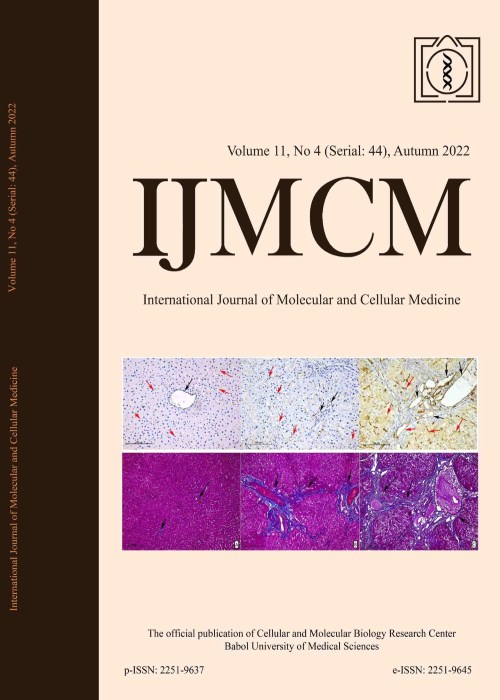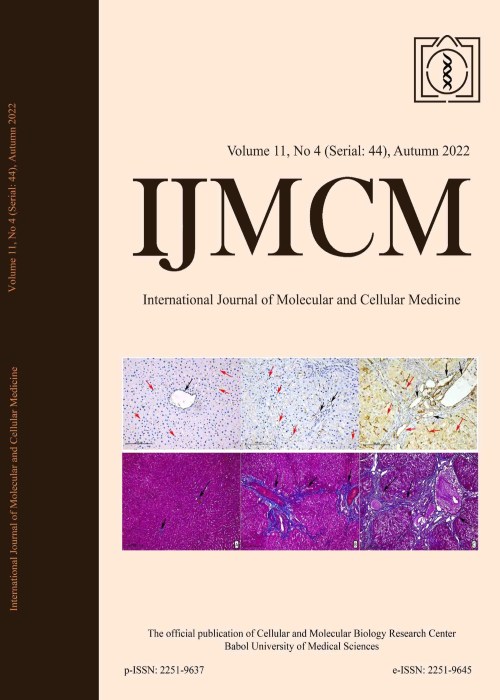فهرست مطالب

International Journal of Molecular and Cellular Medicine
Volume:12 Issue: 45, Winter 2023
- تاریخ انتشار: 1402/08/14
- تعداد عناوین: 8
-
-
Pages 1-17
Leukemia is a type of cancer that affects the blood and bone marrow. Acute lymphoid leukaemia, also known as ALL, is regarded as one of the deadliest forms of cancer. Due to the rapid increase in various cancer cases and the development of resistance in cancer cells, it is necessary to identify novel lead molecules with more potent anticancer properties. There is a growing interest in using herbal products/analogs as multi-component agents (as anticancer agents and immunomodulators) for cancer treatment. In the present investigation, an attempt has been made to explore the anticancer and immunomodulatory activity of P19, an analog of parthenin in ALL. P19 was reported to exhibit anticancer efficacy by triggering apoptotic signaling events in human leukaemia HL-60 cells by significant NO production. In contrast to this finding, ROS and NO were not required for P19-mediated apoptosis in Raji cells. The mechanism of action of P19 was observed to be cancer cell lineage dependent. P19 demonstrated very effective anticancer properties against ALL (IC50 3µM). Molecular investigations revealed that P19 induced mitochondrion mediated apoptosis by Bax localization to mitochondria and enhanced cytosolic calcium in the cytoplasm. Further activation of the caspase 3, caspase 8 and PARP cleavage suggested the involvement of the caspase-mediated apoptosis. Anti-proliferative activity revealed the telomerase inhibition and cell cycle arrest in G0/G1 phase after P19 treatment. Immunomodulatory effects of the P19 revealed the enhanced INFɣ and NO production in Jurkat and THP cells. Owing to its antiproliferative and immunomodulatory potential against leukemia cells P19 can further be explored as effective therapeutics against leukemia.
Keywords: Acute lymphoid leukemia, apoptosis, immunomodulation, anticancer, Raji cells -
Pages 18-29
Acute myeloid leukemia (AML) is an invasive form of hematologic malignancies which results in the overproduction of myeloid cells in the bone marrow. Aberrant expression of piwi-interacting RNAs (piRNAs) which belong to small non-coding RNAs, play important roles in different cancer cells' progress. hsa- piR- 32877 is up-regulated in AML. Down regulation of hsa-piR-32877 by antisense LNA GapmeRs could be potential for suppression of myeloid cell proliferation and induce myeloid cell apoptosis. We have blocked the expression of hsa-piR-32877 by antisense LNA GapmeRs in human bone marrow blast cells, and the M-07e cell line. Samples were transfected with antisense LNA GapmeRs at 24, 48, and 72 hours. The Quantitative reverse transcriptase polymerase chain reaction (qRT-PCR) was performed to investigate the expression of hsa-piR-32877, CASP3, and CASP9. Both CASP3 and CASP9 play important roles in apoptosis. Cell proliferation was studied via CFSE (carboxyfluorescein diacetate succinimidyl ester) assay. Results showed that hsa-piR-32877 was down-regulated by antisense LNA GapmeRs in the patient and cell line samples. Also, after transfection, cell proliferation and apoptosis decreased and increased, respectively. Our data suggested that hsa-piR-32877 suppression may act as a novel therapeutic method for the inhibition of human leukemic cells proliferation in AML.
Keywords: Acute myeloid leukemia, Antisense LNA GapmeRs, hsa-piR-32877, CASP3, CASP9 -
Pages 30-39
Dysregulation of brain cholesterol homeostasis causes the accumulation of extracellular protein deposits called amyloid plaques in the hippocampus which eventually leads to neuronal death, memory and learning deficits. The aim of the present study was to investigate the effect of beta amyloid on miRNAs regulating HMGCR and ABCA1 as cholesterol synthesis and homeostasis genes. Primary astrocytes were isolated from C57BL/6J mice, and were treated with 0.5 μM amyloid beta (Aβ). Expression levels of genes and miRNAs were measured by real-time PCR. In comparison to control, Aβ treatment resulted in a significant decrease in miR-96-5p expression as a positive and negative regulator of HMGCR and ABCA1, respectively. There was no significant increase in miR-27a-3p expression as a negative regulator of HMGCR. miR-106b-5p and miR-143-3p expressions were also dramatically decreased as ABCA1 negative regulators. Amyloid beta can alter the expression of major genes in the cholesterol homeostasis pathway via their regulatory miRNAs.
Keywords: ABCA1, HMGCR, microRNA, astrocytes, amyloid beta -
Pages 40-50
Gaucher's disease (GD) is the most frequent lysosomal storage disorder resulting from a deficiency of the enzyme glucocerebrosidase (GBA) which causes the accumulation of glucocerebroside. More than 500 mutations have been reported on the GBA gene so far. In this study, we aimed to investigate more on the genotype of less known mutations through haplotype analysis to explain their disease-causing inheritance. Eight patients and three carriers from nine different families were enrolled in the study. DNA sequencing of all GBA gene’s exons was performed and pathogenicity of the mutations was investigated. Using GBA gene-linked STR markers, allele segregations were determined in some families. A total of six different mutations were determined. Five and three patients were identified to carry mutations in homozygous and compound heterozygote patterns respectively, three participants also were identified as carriers. The most prevalent mutations were c.1448 T>C and RecNcil, however, three less common mutations were identified (i.e., c.1223 C>T, c.1315 A>G, and c.1214 G>C). In conclusion, we evaluated six different mutations in Iranian patients and elucidated the inheritance of the three less-known mutations by linkage analysis.
Keywords: Gaucher disease, beta-glucocerebrosidase, lysosomal storage disorder, haplotype analysis, Iran -
Pages 51-69
The increasing global public health concern of antimicrobial resistance (AMR) necessitates exploration of natural antimicrobial agents as potential alternatives. This study aimed to investigate antimicrobial activities of Saharan actinomycetes, with specific focus on the strain Streptomyces fimbriatus AC31, that holds promising potential as an alternative to combat AMR. In this context, 32 actinomycetes were isolated from El Atteuf (Ghardaïa), Algeria. Isolates obtained were characterized morphologically and biochemically. Screened isolate was identified by 16S rRNA gene sequencing. Classification of actinomycete isolates was carried out by UPGMA (Unweighted Pair Group Method with Arithmetic Mean). Then, they were screened for their antimicrobial activity by cross-streak method. Identification of 32 isolates revealed 5 genera: Streptomyces (65.63%), Nocardia (9.38%), Streptosporangium (9.38%), Nocardiopsis (9.38%) and Actinomadura (6.25%). According to the biochemical and physiological characteristics, UPGMA classified the isolates in 4 phenons. A number of 24 (75.00%) isolates were active against Gram-positive bacteria, 21 (65.63%) isolates were effective against Gram-negative bacteria, and 25 (78.13%) isolates inhibited Candida albicans. Screened strain Streptomyces fimbriatus AC31 showed highest antagonistic activity and revealed an inhibition zones of 41, 38, 41, 42, and 44 mm, against B. subtilis (ATCC 6633), E. coli (ATCC 8739), S. typhimurium (ATCC 13331), S. aureus (ATCC 6538) and C. albicans (ATCC 10231), respectively. Phylogenetic identification of the AC 31 isolate using 16S rRNA gene sequence showed similarity of 100% with Streptomyces fimbriatus NBRC 15411T. Actinomycete isolates characterized in this study were endowed with antimicrobial activity against various pathogenic microorganisms that could be used efficiently in developing new antimicrobial substances.
Keywords: Actinomycetes, antimicrobial activity, Saharan soil, screening -
Pages 70-80
Polycystic ovary syndrome is a low-grade inflammatory state with increased serum levels of TNF-α. The present study has compared the inflammatory responses to breast cancer cell lines in women with PCOS with healthy women. Peripheral blood mononuclear cells (PBMCs) isolated from 50 women with PCOS and 50 healthy controls were cultured in the trans-well co-culture system. These cells were stimulated with two distinct breast cancer cell lines. The proliferation of PBMCs, CD3+CD8+T cell percentages, and tumor necrosis factor-alpha (TNF-α) concentration were evaluated after 48 and 72 hours of incubation. TNF-α concentration and the proliferation rate of PBMCs after 48 hours of incubation significantly increased in the PCOS group. However, after 72 hours, TNF-α secretion significantly decreased in the PCOS group. The ability of PBMCs to produce TNF-α decreased gradually in women with PCOS. When the effects of low-grade inflammation and endocrine conditions on the cells decrease, the inability of PBMCs to create an inflammatory response will be altered.
Keywords: Inflammatory response, polycystic ovary syndrome, TNFα, breast cancer -
Pages 81-85
Triploidy is a lethal chromosomal abnormality. Fetuses with triploid condition have a tendency to die in early conception and very few survive to term. In this study, we report the prenatal diagnosis of fetal triploidy with unexpected chromosomal translocation. A 27 years old women was referred to our clinical cytogenetic department due to history of previous conceptus with intrauterine growth retardation at 21-22 weeks of gestation and in present pregnancy, the quadruple marker screen test had suggested a high risk for Trisomy 18 with the risk >1:50. The study was performed on the amniotic fluid and peripheral blood samples received at the clinical cytogenetics department. The interphase FISH and conventional karyotype methods were followed. The prenatal diagnosis using an amniotic fluid sample found a triploid fetus with unexpected balanced chromosomal translocation: 69,XXX,t(2;9)(q11.2;p22)x2. Later the origin of translocation was confirmed by parental chromosomal study. Cytogenetic analysis showed the presence of translocation involving chromosome 2 and 9 in the mother which confirms the maternal origin of translocation in fetal triploidy. Prenatal diagnosis of fetal triploidy with balanced translocation of maternal origin is a rare finding. In present study, the triploidy arises from the failure to expel the second polar body. It is important to perform prenatal fetal imaging with ultrasound at 18-22 weeks to identify any fetal anomalies or intrauterine growth retardation which is associated with triploidy.
Keywords: Prenatal diagnosis, fetal abnormality, amniocentesis, balanced translocation, aneuploidy detection, genetic counseling -
Pages 86-99
Existing therapeutic interventions for controlling cancer are limited and associated with side effects. Furthermore, the recurrence of cancer poses a significant challenge to the cure of cancer. Therefore, avenues are wanted to find novel therapies for cancer treatment and cancer recurrence. In this review, we have highlighted that lactoferrin (LF) and activated protein C (APC) carry enormous potential in cancer treatment. Studies have shown that the decreased level of APC and impaired function of APC are associated with cancer progression and cancer-related mortality. Moreover, APC plays an important role in preventing prothrombotic state-mediated cancer progression and deaths. LF can also inhibit the progression of cancer by controlling the generation of reactive oxygen species, triggering the apoptosis of cancer cells, arresting the cell cycle and hindering the angiogenesis process. Additionally, APC and LF could have the potential to inhibit neutrophil extracellular traps (NETs) formations which are involved in cancer progression and the reawakening of dormant cancer cells. Hence, in this review, the anticancer potential and mechanism of APC and LF along with their potential to mitigate inflammation and NETs-mediated cancer progression and recurrence has been discussed. Additionally, possible future strategies to develop effective and safe anticancer treatment using LF and APC have also been discussed in this review.
Keywords: Cancer, activated protein C, Lactoferrin, neutrophil extracellular traps, cancer treatment


